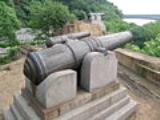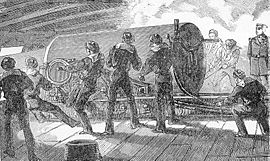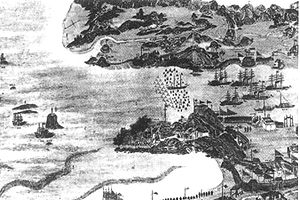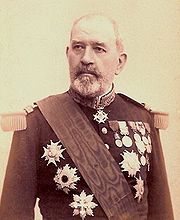
Battle of Zhenhai
Encyclopedia
The so-called Battle of Zhenhai was a minor confrontation on 1 March 1885 between Admiral Amédée Courbet
's Far East Squadron
(escadre de l’extrême-Orient) and Chinese warships and shore batteries near the coastal city of Zhenhai
, 12 miles downstream of Ningbo
, during the Sino-French War
(August 1884–April 1885). The 'battle' is of some interest because the French and Chinese sources disagree sharply on what happened. French sources treated the encounter as a minor incident, while Chinese sources celebrated it as a striking defensive victory. The 'battle of Zhenhai' is still commemorated in China as an important Chinese victory in the Sino-French War.
 In early February 1885 part of Admiral Courbet's Far East Squadron
In early February 1885 part of Admiral Courbet's Far East Squadron
left Keelung to head off a threatened attempt by part of the Chinese Nanyang Fleet
(Southern Seas fleet) to break the French blockade of Formosa (Taiwan). On 11 February Courbet's task force met the cruisers Kaiji (開濟), Nanchen (南琛) and Nanrui (南瑞), three of the most modern ships in the Chinese fleet, near Shipu Bay, accompanied by the frigate Yuyuan (馭遠) and the composite sloop Chengqing (澄慶). The Chinese flotilla, under the command of Admiral Wu Ankang (吳安康), scattered at the French approach, and while the three cruisers successfully made their escape, the French succeeded in trapping Yuyuan and Chengqing in Shipu Bay. On the night of 14 February, in the Battle of Shipu
, both ships were crippled in a daring French torpedo attack, Yuyuan by a French spar torpedo and Chengqing by Chinese artillery.
On 25 February 1885 Admiral Courbet was instructed to implement a 'rice blockade', to prevent ships carrying rice from leaving Shanghai for northern China. On 28 February he arrived off Zhenhai Bay, en route for Shanghai, with the ironclads Bayard and Triomphante, the cruiser Nielly and the troopship Saône. Suspecting that Kaiji, Nanchen and Nanrui had taken refuge in Zhenhai Bay, Courbet scouted the entrance to the bay at dawn on 1 March. Not only could he see the masts of the three Chinese cruisers, but he was also able to identify four other Chinese warships: the composite sloop Chaowu (超武), the wooden transport Yuankai (元凱), and two 'alphabetical' gunboats. The entrance to the bay had been blocked by a barrage of sunken junks by the Chinese authorities, and was also defended by two recently-built forts.
.jpg)
 Early in the afternoon of 1 March Courbet reconnoitred closer on board Nielly. The Chinese shore batteries and Chinese warships opened a vigorous fire. They were firing at extreme long range, but some of their shots landed within a hundred metres of the French cruiser. Unharmed, Nielly returned fire and slowly rejoined the squadron. The duel lasted a little over half an hour, and it is doubtful whether Nielly’s fire was much more effective than that of the Chinese, though the French claimed to have killed a number of soldiers ashore and inflicted slight damage on one of the shore batteries.
Early in the afternoon of 1 March Courbet reconnoitred closer on board Nielly. The Chinese shore batteries and Chinese warships opened a vigorous fire. They were firing at extreme long range, but some of their shots landed within a hundred metres of the French cruiser. Unharmed, Nielly returned fire and slowly rejoined the squadron. The duel lasted a little over half an hour, and it is doubtful whether Nielly’s fire was much more effective than that of the Chinese, though the French claimed to have killed a number of soldiers ashore and inflicted slight damage on one of the shore batteries.
On the evening of 1 March Courbet gave orders for an attack the next day, but on the morning of 2 March the risks of the operation became evident. Silencing the Chinese batteries would be a long and slow business, and while the French ironclads were duelling with the forts they would be exposed to the fire of the three Chinese cruisers. Even if the French warships succeeded in suppressing the Chinese defences and forcing the barrage, the Chinese cruisers might still have eluded them by heading upriver towards Ningbo. Courbet decided not to incur unnecessary casualties, and cancelled the planned attack.
 On 2 March the French ships rested. On 3 March Courbet had soundings taken at various points around the entrance to the bay, in a vain search for a position from which the French ironclads could reach the Chinese cruisers with their guns without coming under fire from the Chinese forts. There were no such positions, and Courbet eventually issued orders for a blockade of Zhenhai Bay. Nets were spread around the French ships, as a precaution against a possible Chinese torpedo attack. A watch was kept around the clock on the entrance to the bay, and any junks or sampans that came too close to the French ships were fired on.
On 2 March the French ships rested. On 3 March Courbet had soundings taken at various points around the entrance to the bay, in a vain search for a position from which the French ironclads could reach the Chinese cruisers with their guns without coming under fire from the Chinese forts. There were no such positions, and Courbet eventually issued orders for a blockade of Zhenhai Bay. Nets were spread around the French ships, as a precaution against a possible Chinese torpedo attack. A watch was kept around the clock on the entrance to the bay, and any junks or sampans that came too close to the French ships were fired on.
These precautions turned out to be unnecessary. Far from making plans for an attack on the French squadron, the Chinese commanders appear to have been afraid that the French would send their torpedo boats into the Ningpo river to repeat their recent triumph in the Battle of Shipu
. On the night of 2 March, as the French squadron lay at anchor, a searchlight suddenly began to sweep the Chinese barrage, several flares soared into the air, and the sound of cannon fire and rifle fire from within the bay disturbed the silence of the night. Nervous Chinese sentries had mistakenly identified a harmless fishing boat as a French torpedo boat and immediately given the alarm. The French listened in disbelief as the Chinese blazed away until dawn at an imaginary enemy.
The scene was repeated, on an almost nightly basis, for the rest of the month. At least two ships of the Far East Squadron
remained anchored at the entrance to Zhenhai Bay throughout March. Apparently unable or unwilling to attack the French warships, the Chinese treated them instead to an expensive firework display. Whether the Chinese commanders were still haunted by the fear of a night torpedo attack or were simply attempting to cheer up their troops, the results were pleasing enough. One or two of the more professionally-minded French officers complained at the prodigious waste of ammunition sanctioned by the enemy generals, but most enjoyed the nocturnal display of flashes and detonations above Zhenhai Bay as a welcome respite from the tedium of blockade service. The only significant incident of the blockade was a brief cannonade by the French ships towards the end of March, to prevent the Chinese from attempting to repair their damaged forts.
 As far as the French were concerned, they had bottled up seven Chinese warships in Zhenhai Bay, where they remained immobilised for the rest of the war. Although Courbet had not gone in after them, locating and trapping the Chinese warships ranked as a strategic success comparable to the destruction of Yuyuan and Chengqing a fortnight earlier. But that was not how the Chinese saw things. Courbet’s decision not to force the defences of Zhenhai Bay allowed the Chinese to claim the brief engagement on 1 March as a striking defensive victory. The half-hour exchange of shots between Nielly and the Chinese shore batteries became a six-hour battle in which Courbet’s ships were roughly handled and the French commander was seriously wounded, and the brief engagement on 1 March was stretched into a three-day battle from 1 to 3 March, in which the French repeatedly attacked and were repulsed.
As far as the French were concerned, they had bottled up seven Chinese warships in Zhenhai Bay, where they remained immobilised for the rest of the war. Although Courbet had not gone in after them, locating and trapping the Chinese warships ranked as a strategic success comparable to the destruction of Yuyuan and Chengqing a fortnight earlier. But that was not how the Chinese saw things. Courbet’s decision not to force the defences of Zhenhai Bay allowed the Chinese to claim the brief engagement on 1 March as a striking defensive victory. The half-hour exchange of shots between Nielly and the Chinese shore batteries became a six-hour battle in which Courbet’s ships were roughly handled and the French commander was seriously wounded, and the brief engagement on 1 March was stretched into a three-day battle from 1 to 3 March, in which the French repeatedly attacked and were repulsed.
The Chinese version crystallised shortly after the war, with the erection of a commemorative tablet near the site of the engagement in 1889 by the Chinese general Ouyang Lijian (歐陽利見), who had been charged with the defence of Ningbo and Zhenhai. According to Ouyang's account, the defence of the town was in the hands of the Chinese military mandarins Xue Fucheng (薛福成), Liu Bingzhang (劉秉璋) and himself. The hero of the battle was the artillery officer Wu Jie (吳杰), who directed the fire of a battery of cannon. Wu Jie defied direct orders not to fire on the French, and precipitated the battle by ordering his men to open fire. The Chinese cannon inflicted terrible damage on the French ships, hitting both Bayard and Nielly, and a shot aimed in person by Wu Jie severely wounded the ‘terrible Guba’ (as the Chinese called Courbet). After the battle was over, Wu Jie expected to be commended for his prowess. Instead, he was punished for disobedience.
 Interesting light on Ouyang Lijian's patriotic account is shed by the testimony of L. C. Arlington, an American naval officer serving as a 'foreign adviser' with the Nanyang Fleet at Zhenhai. According to Arlington, the Zhenhai authorities were extremely reluctant to allow Admiral Wu Ankang to take refuge in Zhenhai Bay with his three cruisers. Fearful of drawing the French down upon their heads, they begged him to go elsewhere, and Admiral Wu threatened to take his ships upriver to Ningbo and leave them to deal with the French squadron on their own. When the French appeared off Zhenhai on 28 February, the land authorities urged Wu to sail out and attack the French with the seven ships at his disposal. Wu, wisely in Arlington's opinion, refused to do so. None of the Chinese or foreign naval officers believed that Wu's ships would win such a battle.
Interesting light on Ouyang Lijian's patriotic account is shed by the testimony of L. C. Arlington, an American naval officer serving as a 'foreign adviser' with the Nanyang Fleet at Zhenhai. According to Arlington, the Zhenhai authorities were extremely reluctant to allow Admiral Wu Ankang to take refuge in Zhenhai Bay with his three cruisers. Fearful of drawing the French down upon their heads, they begged him to go elsewhere, and Admiral Wu threatened to take his ships upriver to Ningbo and leave them to deal with the French squadron on their own. When the French appeared off Zhenhai on 28 February, the land authorities urged Wu to sail out and attack the French with the seven ships at his disposal. Wu, wisely in Arlington's opinion, refused to do so. None of the Chinese or foreign naval officers believed that Wu's ships would win such a battle.
According to Arlington, the Chinese gunners were reluctant to fire on the French on 1 March, and the artillery duel was precipitated by a German gunner named Jerkins, who opened fire without orders on one of the French ships. A shot from Admiral Courbet's flagship, the ironclad Bayard (incorrectly identified as her sister ship Atalante by Arlington), hit the artillery battery that had opened fire, killing 26 Chinese soldiers and wounding 30 more. The engagement developed and spread, eventually drawing in all the Chinese shore batteries and all the Chinese warships.
Arlington also mentions a second engagement on 3 March, in which a French warship was damaged. This engagement is not mentioned in any French source.
 Preliminaries of peace between France and China were signed on 4 April 1885, but the French maintained their blockades of Zhenhai and the Yangzi River until a substantive peace treaty ending the Sino-French War (the Treaty of Tientsin) was signed on 9 June. On 11 June 1885 Admiral Courbet died of dysentery aboard his flagship Bayard in Makung harbour, where most of the Far East Squadron
Preliminaries of peace between France and China were signed on 4 April 1885, but the French maintained their blockades of Zhenhai and the Yangzi River until a substantive peace treaty ending the Sino-French War (the Treaty of Tientsin) was signed on 9 June. On 11 June 1885 Admiral Courbet died of dysentery aboard his flagship Bayard in Makung harbour, where most of the Far East Squadron
had been stationed since the end of the Pescadores Campaign
(late March 1885). On 13 June Admiral Adrien-Barthélémy-Louis Rieunier, who was then stationed off Shanghai with the ironclad Turenne, officially notified the Chinese authorities at Shanghai of Courbet's death. He also sent word to the military commissioner Ouyang Lijian at Zhenhai. As France and China were now at peace, the Chinese lowered their flags to half-mast from the Zhenhai shore batteries, in accordance with international protocol. Only three months earlier, these same batteries had done their best to kill the French admiral.
Admiral Rieunier later heard that the French might have captured all seven Chinese ships without loss had they attacked the Zhenhai defences on 2 March 1885. The French admiral was told shortly after the end of the war by the British consul at Ningbo that Courbet’s arrival had created such alarm that the Chinese ship captains were ready to surrender if the French made a serious attack on the defences of Zhenhai. As the British were keen to preserve their neutrality, the consul had punctiliously refrained from conveying this valuable information to the French.
Amédée Courbet
Anatole-Amédée-Prosper Courbet was a French admiral who won a series of important land and naval victories during the Tonkin campaign and the Sino-French War .-Early years:...
's Far East Squadron
Far East Squadron
The French Far East Squadron was an exceptional naval grouping created for the duration of the Sino-French War .- Background :...
(escadre de l’extrême-Orient) and Chinese warships and shore batteries near the coastal city of Zhenhai
Zhenhai
Zhenhai is a district of Ningbo prefecture-level city, Zhejiang, and also a town within that district. Located at the mouth of the Yong River 12 miles north-east of Ningbo proper, the town of Zhenhai lies at the foot of Zhaobao Hill on a tongue of land...
, 12 miles downstream of Ningbo
Ningbo
Ningbo is a seaport city of northeastern Zhejiang province, Eastern China. Holding sub-provincial administrative status, the municipality has a population of 7,605,700 inhabitants at the 2010 census whom 3,089,180 in the built up area made of 6 urban districts. It lies south of the Hangzhou Bay,...
, during the Sino-French War
Sino-French War
The Sino–French War was a limited conflict fought between August 1884 and April 1885 to decide whether France should replace China in control of Tonkin . As the French achieved their war aims, they are usually considered to have won the war...
(August 1884–April 1885). The 'battle' is of some interest because the French and Chinese sources disagree sharply on what happened. French sources treated the encounter as a minor incident, while Chinese sources celebrated it as a striking defensive victory. The 'battle of Zhenhai' is still commemorated in China as an important Chinese victory in the Sino-French War.
Background

Far East Squadron
The French Far East Squadron was an exceptional naval grouping created for the duration of the Sino-French War .- Background :...
left Keelung to head off a threatened attempt by part of the Chinese Nanyang Fleet
Nanyang Fleet
The Nanyang Fleet was one of the four modernised Chinese navies in the late Qing Dynasty. Established in the 1870s, the fleet suffered losses in the Sino-French War, escaped intact in the Sino-Japanese War, and was formally abolished in 1909....
(Southern Seas fleet) to break the French blockade of Formosa (Taiwan). On 11 February Courbet's task force met the cruisers Kaiji (開濟), Nanchen (南琛) and Nanrui (南瑞), three of the most modern ships in the Chinese fleet, near Shipu Bay, accompanied by the frigate Yuyuan (馭遠) and the composite sloop Chengqing (澄慶). The Chinese flotilla, under the command of Admiral Wu Ankang (吳安康), scattered at the French approach, and while the three cruisers successfully made their escape, the French succeeded in trapping Yuyuan and Chengqing in Shipu Bay. On the night of 14 February, in the Battle of Shipu
Battle of Shipu
The Battle of Shipu was a French naval victory during the Sino-French War . The battle took place on the night of 14 February 1885 in Shipu Bay , near Ningbo, China.- Background :...
, both ships were crippled in a daring French torpedo attack, Yuyuan by a French spar torpedo and Chengqing by Chinese artillery.
On 25 February 1885 Admiral Courbet was instructed to implement a 'rice blockade', to prevent ships carrying rice from leaving Shanghai for northern China. On 28 February he arrived off Zhenhai Bay, en route for Shanghai, with the ironclads Bayard and Triomphante, the cruiser Nielly and the troopship Saône. Suspecting that Kaiji, Nanchen and Nanrui had taken refuge in Zhenhai Bay, Courbet scouted the entrance to the bay at dawn on 1 March. Not only could he see the masts of the three Chinese cruisers, but he was also able to identify four other Chinese warships: the composite sloop Chaowu (超武), the wooden transport Yuankai (元凱), and two 'alphabetical' gunboats. The entrance to the bay had been blocked by a barrage of sunken junks by the Chinese authorities, and was also defended by two recently-built forts.
The 'battle of Zhenhai', 1 March 1885
.jpg)

On the evening of 1 March Courbet gave orders for an attack the next day, but on the morning of 2 March the risks of the operation became evident. Silencing the Chinese batteries would be a long and slow business, and while the French ironclads were duelling with the forts they would be exposed to the fire of the three Chinese cruisers. Even if the French warships succeeded in suppressing the Chinese defences and forcing the barrage, the Chinese cruisers might still have eluded them by heading upriver towards Ningbo. Courbet decided not to incur unnecessary casualties, and cancelled the planned attack.
The French blockade of Zhenhai, March–June 1885

These precautions turned out to be unnecessary. Far from making plans for an attack on the French squadron, the Chinese commanders appear to have been afraid that the French would send their torpedo boats into the Ningpo river to repeat their recent triumph in the Battle of Shipu
Battle of Shipu
The Battle of Shipu was a French naval victory during the Sino-French War . The battle took place on the night of 14 February 1885 in Shipu Bay , near Ningbo, China.- Background :...
. On the night of 2 March, as the French squadron lay at anchor, a searchlight suddenly began to sweep the Chinese barrage, several flares soared into the air, and the sound of cannon fire and rifle fire from within the bay disturbed the silence of the night. Nervous Chinese sentries had mistakenly identified a harmless fishing boat as a French torpedo boat and immediately given the alarm. The French listened in disbelief as the Chinese blazed away until dawn at an imaginary enemy.
The scene was repeated, on an almost nightly basis, for the rest of the month. At least two ships of the Far East Squadron
Far East Squadron
The French Far East Squadron was an exceptional naval grouping created for the duration of the Sino-French War .- Background :...
remained anchored at the entrance to Zhenhai Bay throughout March. Apparently unable or unwilling to attack the French warships, the Chinese treated them instead to an expensive firework display. Whether the Chinese commanders were still haunted by the fear of a night torpedo attack or were simply attempting to cheer up their troops, the results were pleasing enough. One or two of the more professionally-minded French officers complained at the prodigious waste of ammunition sanctioned by the enemy generals, but most enjoyed the nocturnal display of flashes and detonations above Zhenhai Bay as a welcome respite from the tedium of blockade service. The only significant incident of the blockade was a brief cannonade by the French ships towards the end of March, to prevent the Chinese from attempting to repair their damaged forts.
The Chinese version

The Chinese version crystallised shortly after the war, with the erection of a commemorative tablet near the site of the engagement in 1889 by the Chinese general Ouyang Lijian (歐陽利見), who had been charged with the defence of Ningbo and Zhenhai. According to Ouyang's account, the defence of the town was in the hands of the Chinese military mandarins Xue Fucheng (薛福成), Liu Bingzhang (劉秉璋) and himself. The hero of the battle was the artillery officer Wu Jie (吳杰), who directed the fire of a battery of cannon. Wu Jie defied direct orders not to fire on the French, and precipitated the battle by ordering his men to open fire. The Chinese cannon inflicted terrible damage on the French ships, hitting both Bayard and Nielly, and a shot aimed in person by Wu Jie severely wounded the ‘terrible Guba’ (as the Chinese called Courbet). After the battle was over, Wu Jie expected to be commended for his prowess. Instead, he was punished for disobedience.
Arlington's version

According to Arlington, the Chinese gunners were reluctant to fire on the French on 1 March, and the artillery duel was precipitated by a German gunner named Jerkins, who opened fire without orders on one of the French ships. A shot from Admiral Courbet's flagship, the ironclad Bayard (incorrectly identified as her sister ship Atalante by Arlington), hit the artillery battery that had opened fire, killing 26 Chinese soldiers and wounding 30 more. The engagement developed and spread, eventually drawing in all the Chinese shore batteries and all the Chinese warships.
Arlington also mentions a second engagement on 3 March, in which a French warship was damaged. This engagement is not mentioned in any French source.
Aftermath

Far East Squadron
The French Far East Squadron was an exceptional naval grouping created for the duration of the Sino-French War .- Background :...
had been stationed since the end of the Pescadores Campaign
Pescadores Campaign
The Pescadores Campaign in late March 1885 was one of the last campaigns of the Sino-French War . It was fought to capture a strategically important island group off the western coast of Taiwan...
(late March 1885). On 13 June Admiral Adrien-Barthélémy-Louis Rieunier, who was then stationed off Shanghai with the ironclad Turenne, officially notified the Chinese authorities at Shanghai of Courbet's death. He also sent word to the military commissioner Ouyang Lijian at Zhenhai. As France and China were now at peace, the Chinese lowered their flags to half-mast from the Zhenhai shore batteries, in accordance with international protocol. Only three months earlier, these same batteries had done their best to kill the French admiral.
Admiral Rieunier later heard that the French might have captured all seven Chinese ships without loss had they attacked the Zhenhai defences on 2 March 1885. The French admiral was told shortly after the end of the war by the British consul at Ningbo that Courbet’s arrival had created such alarm that the Chinese ship captains were ready to surrender if the French made a serious attack on the defences of Zhenhai. As the British were keen to preserve their neutrality, the consul had punctiliously refrained from conveying this valuable information to the French.

